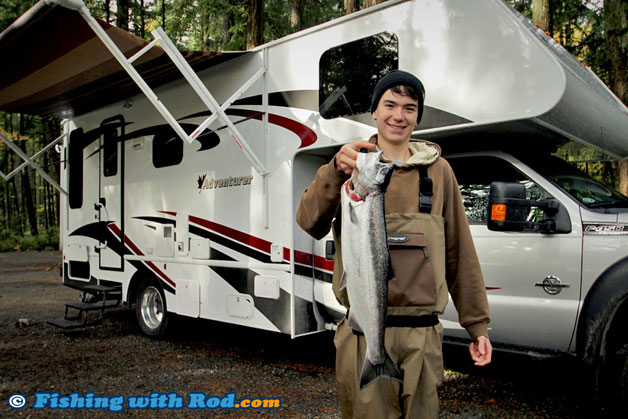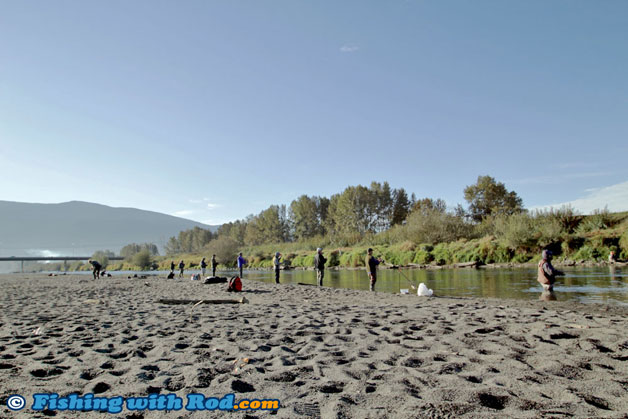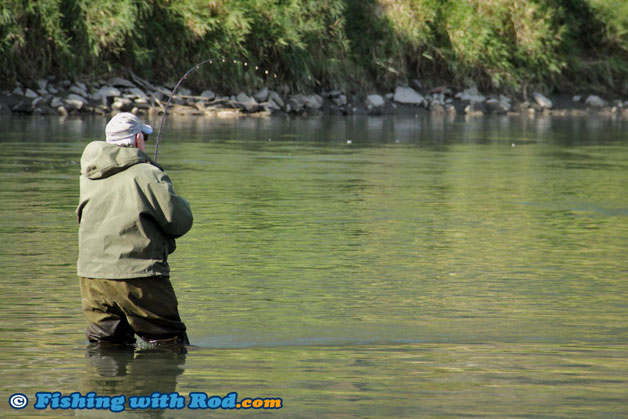Planning the Perfect River Salmon Fishing Trip
By Rodney Hsu, Fishing with Rod | Published in October 2015

River fishing in the fall for salmon can be excellent in Southwestern British Columbia. With chinook, coho, and chum salmon all returning at the same time in October and November, anglers are spoiled with plenty of fishing opportunities. The return of salmon also drives big crowds of anglers to the rivers, this is especially true for rivers close to urbanized areas. New anglers often find it difficult to catch a salmon because the crowd, the weather, the river conditions sometimes do not cooperate. Here are some tips which you can use to plan your trip so you can have a good river salmon fishing experience.
Do Your Leg Work!
Do the leg work! Like all fisheries, there isn't one single best fishing spot along the river. This is particular true for river salmon fishing, because fish are constantly on the move to their spawning grounds. The river also changes over time. A perfectly fishable run during one year, can easily be gone the following year due to gravel movement. Fishing results also change daily so it is a good idea to have a list of fishing spots to choose from, instead of relying on second hand fishing reports. Prior to the salmon fishing season, if time isn't a luxury, pick a day and walk the river where you intend to fish and make note of where all the potentially good fishing spots are.
Preparing for the Trip
When the salmon are biting, it can be fast and short lived, therefore it is important to have your gear in working order throughout your trip. Prior to your fishing trip, make sure the guides of your rod are cleaned, the reel is lubed, extra leaders are tied, and bait is packed. Try minimizing the amount of items you need to carry. Your fishing gear is best carried tightly in a vest or pack. I prefer to use a waist pack so my shoulders are not strained. A large hand held tackle box is not ideal for river fishing, because your hands are needed to constantly work the rod and reel.
A pair of waders gives you more options to fish. More often than not, there is a channel where you need to wade across to where you want to fish. Chest waders allow you to do so without getting wet, they keep your warm on rainy days so you can focus on the fishing. Waders also make landing or releasing a fish easier.
The Right Place at the Right Time
Salmon in a heavily fished river systems such as the Chilliwack/Vedder River are more challenging to catch due to frequent disturbance. The best time to catch salmon in these situations is very first thing in the morning, especially on a sunny day. Arriving at your spot before sunrise can significantly improve your success. If that option is not available, then try late afternoon around dusk, when fish are also not as shy. If the river is influenced by the tide, you should plan your trip to coincide with the tide change. Incoming tides can stimulate the fish to move and bite, even in the middle of a sunny day.

As tempting as it can be, avoid fishing in crowded spots. Crowds are drawn to spots where fish are believed to be holding. Even if fish are abundant, they are most likely spooked and hard to entice. A better option is to walk to a quiet spot, which is often nearby, and fish for salmon which have not been disturbed. The experience of fishing away from crowds is also much more pleasant, tangles and other potential conflicts can be avoided.
Know Your Target Species
Too often new anglers show up at the river without knowing what they wish to catch, and aimlessly cast and hope to catch a fish. Your trips can significantly improve if you know your objectives and target species. The fishing gear used to target each salmon species and the types of water best for them are all very different. Dragging a hook dressed with a piece of wool close to the bottom may accidentally hook a few fish, but it will not produce consistently. Check out our river fishing articles to learn more.
Pay Attention to the Weather and River Conditions
The fall river salmon fishery is very weather dependent. Early in the season the weather is typically very dry, therefore river level is quite low. As a result, fish will only hold in certain spots. Contrary to what many believe, salmon will still move upstream in low water conditions, but it is usually done at night. Fishing is not necessarily limited to the lower part of a river, but you need to explore and find the deeper spots where they hide during the day.
When rain arrives, the river rises. The first bump of water level is usually excellent for fishing as fresh fish will be moving upstream constantly. As more rain falls and river level spikes, water clarity will degrade and fishing will be poor again because fish cannot see your offerings. Once it stops raining, and the river level recedes, fishing is often excellent again as fresh fish can now be found throughout the entire river system.
It is important to pay attention to the river level by checking out the hydrograph. Knowing when the river is high or low, clear or dirty, can save you time so you only focus your effort on when the river condition is optimal.

Keep a Fishing Diary
This brings up the final point, keep a diary! It is important to record your fishing results, weather and river conditions after each trip so these entries can be used as a reference for planning trips in the future. If a spot has produced many fish at a certain water level in the past, most likely it will yield the same results in similar conditions again.

